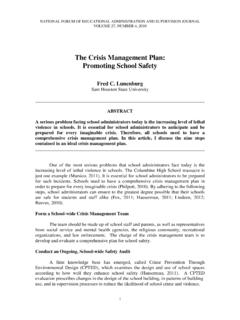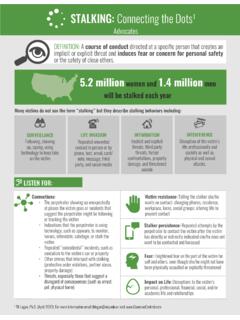Transcription of Preventing Suicide - Program Activities Guide
1 Preventing SuicidePr o g r a m ac t i v i t i e s gu i d eTMNational Center for Injury Prevention and ControlDivision of violence Prevention 2 Preventing SuicideThe FactsSomeone dies by Suicide every 15 minutes. In 2007, more than 34,000 Americans took their own lives. Suicide is the third leading cause of death among 15- to 24-year-olds, the fourth leading cause among 25- to 44-year-olds, and the eighth leading cause among 45- to 64-year-olds. Though Suicide is a serious prob-lem among youth, death rates are highest for people between the ages of 45 and 54 (about 17 per 100,000). When rates are examined by sex, women in the 45 to 54 age group are at greater risk for Suicide , while men over the age of 75 are at greatest risk.
2 The number of deaths from Suicide reflects only a small portion of the impact of suicidal behavior. In 2007, 165,997 people were hospitalized following sui-cide attempts. More than 395,320 were treated in hos-pital emergency departments for self-inflicted of the greatest challenges in the field of Suicide prevention is identifying promising strategies and pro-grams. CDC must continue to research effective preven-tion strategies and to develop and evaluate new ones. CDC will communicate information about what works to practitioners in the field as data become s RoleCDC s violence prevention Activities are guided by four key principles: An emphasis on primary prevention.
3 CDC seeks to stop suicidal behavior before it occurs. This involves reducing the factors that put people at risk for ex-periencing violence . It also includes increasing the factors that protect people or buffer them from risk. A commitment to developing a rigorous science base. CDC s approach includes defining the problem through surveillance, using research to identify risk and protective factors, developing and evaluating new prevention strategies, and ensuring widespread adoption of effective programs. A cross-cutting perspective. Public health encompasses many disciplines and perspectives, making its ap-proach well suited for examining and addressing complex problems like suicidal behavior.
4 A population approach. Part of public health s broad view is an emphasis on population health not just the health of individuals. CDC s strategic direction for Suicide prevention is to promote and enhance connectedness within and among individual persons, families, and communities. CDC is particularly focused on interrupting the devel-opment of suicidal behavior, integrating approaches to Preventing suicidal behavior for those faced with interpersonal violence , and addressing vulnerable populations. CDC s strategy is organized around these four general priorities: Measuring impact Creating and evaluating new approaches to prevention Applying and adapting effective practices Building community capacity for implementing prevention information about CDC s Suicide preven-tion programs and Activities is available at Key PartnersPreventing Suicide and suicidal behavior requires the support and contributions of many partners:federal agencies, state and local health departments, nonprofit organizations, academic institutions, in-ternational agencies, and private industry.
5 Partners help in a variety of ways, including collecting data about Suicide , learning about risk factors, developing strategies for prevention, and ensuring that effective prevention approaches reach those in need. Monitoring, Tracking, and Researching the Problem 3 National Violent Death Reporting SystemState and local agencies have detailed information from medical examiners, coroners, law enforcement, crime labs, and death certificates that could answer important, fundamental questions about trends and patterns in violence . However, the information is fragmented and difficult to access. Eighteen states are currently part of the National Violent Death Report-ing System (NVDRS) Alaska, Colorado, Georgia, Kentucky, Maryland, Massachusetts, Michigan, New Jersey, New Mexico, North Carolina, Ohio, Oklaho-ma, Oregon, Rhode Island, South Carolina, Utah, Vir-ginia, and Wisconsin.
6 These states gather, share, and link state-level data about violence . NVDRS enables CDC and states to access vital, state-level information to gain a more accurate understanding of the prob-lem of violence . This will enable policy makers and community leaders to make informed decisions about violence prevention strategies and programs, includ-ing those that address Suicide . National Survey on Drug Use and Health Data AnalysisCDC is working with the Substance Abuse and Men-tal Health Services Administration to analyze data from the Suicide -related items on the National Survey on Drug Use and Health (NSDUH). The survey is the leading source of information on the prevalence and incidence of the use of alcohol, tobacco, and illicit drugs in the United States.
7 Suicide -related items were changed in calendar year 2008 to allow national and state estimates of suicidal thought and behavior among adults. Scientists are analyzing the data to identify patterns of suicidal thought and behavior as they relate to demographic and social characteristics and associations with substance abuse. This informa-tion will allow state and federal decision-makers and prevention Program practitioners to make informed judgments about where to focus prevention resources. Linking NVDRS data to Department of Defense and Veteran Affairs (VA) Data CDC is working to enhance the National Violent Death Reporting System (NVDRS) to better char-acterize the nature of suicides among current and former military personnel.
8 Specifically, CDC is at-tempting to link data provided by the Department of Defense Suicide Event Report (DoDSER) and the Department of Veterans Affairs (VA) to NVDRS. CDC is also assessing the feasibility of linking VA data to NVDRS through state NVDRS programs. Having a better understanding of the most common contributing factors could help focus military Suicide prevention Electronic Injury Surveillance System - All Injury ProgramThe National Electronic Injury Surveillance System All Injury Program (NEISS-AIP) is operated by the Consumer Product Safety Commission in collab-oration with the National Center for Injury Preven-tion and Control. It provides nationally representative data about all types and causes of nonfatal injuries treated in hospital emergency departments.
9 CDC uses NEISS-AIP data to generate national estimates of nonfatal injuries, including those related to Risk Behavior SurveyCDC s national Youth Risk Behavior Surveillance System Survey (YRBSS) monitors six categories of priority health-risk behaviors among youth and young adults that contribute markedly to the leading causes of death, disability, and social problems among youth and adults in the United States. A national survey is conducted every two years and provides data repre-sentative of 9th through 12th grade students in public and private schools in the United States. The YRBSS examines several types of violence -related behaviors including physical fighting, weapon carrying, dating and sexual violence , and suicidal behavior.
10 4 Defining and Measuring ConnectednessConnectedness is the degree to which a person or group is socially close, interrelated, or shares resourc-es with other persons or groups. A wide range of connectedness concepts have been linked to Suicide and self-directed violence , including social support, social participation, social isolation, social integration, social cohesion, and social capital. CDC is conducting a literature review to identify definitions of con-nectedness and has convened a panel of experts to develop a practical definition of connectedness that could be used to refine the measurement of connect-edness as it relates to self-directed violence . The goal is to improve the utility, measurement, and monitor-ing of connectedness and resilience factors.














